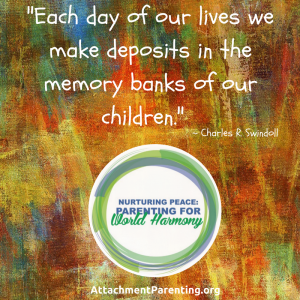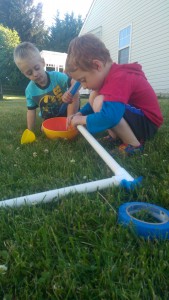Category: Play
Each day of our lives…
Daily Tip: Play as the basis of peace
Editor’s note: Thank you, Art Yuen, API‘s KnowledgeBase Coordinator, for compiling the research to present through these Daily Tips for AP Month 2016, creatively presented by Effie Morchi, assistant editor of APtly Said.
4 positive discipline ideas for toddler hitting
 Hitting is a normal toddler behavior that often begins between ages 1 ½ and 2 years old. There could be many different reasons, including the child being angry but unable to express it or you being unable to understand what he’s trying to express, a life change such as a new sibling, or simply the child wanting to explore what her hand can do and what happens when she hits.
Hitting is a normal toddler behavior that often begins between ages 1 ½ and 2 years old. There could be many different reasons, including the child being angry but unable to express it or you being unable to understand what he’s trying to express, a life change such as a new sibling, or simply the child wanting to explore what her hand can do and what happens when she hits.
So, what can parents do about it?
Shortly after my son’s 2nd birthday and right around the time my next baby was born, my son began hitting. He would hit his brother when he was angry, and sometimes he would hit my husband and me playfully, which was still something we wanted to discourage.
We tried a variety of different strategies to prevent it and teach him not to hit. Here are 4 positive discipline ideas to try if your toddler hits:
- We tried to find new, creative things to do with his hands throughout the day, such as teaching hand-clapping games, different hand gestures like thumbs-up, or sign language — just something to engage the hands in a more productive and fun manner. Sometimes, if I saw he was about to hit playfully, I would try to high-five him instead.
- We also did a lot of soft, nurturing touch with him, like rubbing his arms, and made that more of a part of our day.
- I found that it was really beneficial to give him more outlets to get out some of his physical energy: running outside, finding things that he could throw, and letting him hit a pillow.
- It was important to me to model empathy and try to show that hitting can hurt. If he did hit us, I would often make an exaggerated sad face and say how hurt I was. Once we were out of that immediate moment of his anger — or silliness, in some cases — I would remind him that hitting hurts, that we shouldn’t hit others, and that we have to use soft touch. If he was really angry, we’d talk about other concrete ways that he could express that anger instead. We made a point to model this with his stuffed animals. I have a video of my son when he was two where he hits his stuffed panda and says, “Slap panda.” After a second, he rubs the panda’s arm gently, hugs it, and says, “No, hug. Hug panda!”
What’s most important during a hitting situation is to stay calm and to remember that it is normal part of toddler development. It’s a phase that will pass, and the 4 ideas above may be some techniques to help it pass a little more quickly and smoothly.
Growing up in an attached family, learning the power of stimulus
 My home life was rich in attachment — and stimulus.
My home life was rich in attachment — and stimulus.
Attachment begins with the creation of emotionally close, consistent relationships between parents and children in all child development stages. Then, in order that the child can develop his abilities properly, stimulus is essential.
From an early age, I was inserted into the great world of letters. I remember watching my father carefully reading the dictionary while reading the newspaper. He looked at me and read the new word he had just learned in the dictionary. Even without understanding very well the meaning of words, he regaled me with books, and I loved to flick through the pages, which were rich in colors and illustrations.
My mother also had great motivation for reading. She told me that much of the knowledge she has acquired about parenting and motherhood came from magazines. Thus, I grew up admiring the art to practice a good read, and exchange knowledge with people.
Plays of make-believe nourished my imagination and my childhood. My sister and I loved to invent theater pieces to present to a large, imaginary audience. We used to hang a sheet over a clothes line, which we called “the curtain,” in order to open to the “public” and make our act.
Play is essential in a child’s life, because it creates rhythm and meaning through the senses and movement. It is necessary that parents show interest in the play and first discoveries of children, because these practices create meaning and encouragement for the child.
 I always had a lot of support from my family in all areas of my life, but the most valuable thing I learned from my parents was about the importance of listening to your child. Not just hear through the words, but mostly watching what was not said, the nonverbal messages. In addition, to be able to identify a feeling even when they are not expressed in words, it is necessary to know the temperament of your child and her “intelligences.”
I always had a lot of support from my family in all areas of my life, but the most valuable thing I learned from my parents was about the importance of listening to your child. Not just hear through the words, but mostly watching what was not said, the nonverbal messages. In addition, to be able to identify a feeling even when they are not expressed in words, it is necessary to know the temperament of your child and her “intelligences.”
Howard Gardner is a psychologist and professor known for developing of the theory of multiple intelligences, which points out that a person has multiple intelligences distributed in various skills, such as logical reasoning, language, music, spatial sense, kinesthetic ability, and interpersonal and intrapersonal skills. Transferring the theory of multiple intelligences into parenting, think about learning moments between parents and children through stimulus.
Stimulus is crucial for development. Without stimulus, the child does not learn, cannot feed, does not gain confidence and autonomy, and is unable to strengthen relationships. My childhood was characterized by an attachment-based parenting approach that valued education by stimulus. It was like that when I learned my first numbers and letters through books presented by my father and board games I used to play with my sister, when I perfected my motor coordination and posture through dance classes encouraged by my mother, when I really understood about equilibrium and confidence in the moment that I learned to ride a bike, and when I received encouragement from my parents while I was studying my on my sat prep. It is very important that children can develop everyday experiences to strengthen skills, and the family must be aware of this.
To educate through positive, attachment-based stimulus is to educate for a happier and fulfilling life, promoting the development of more confident children who able to influence the world positively and creatively.
3 tips for connection in the summertime
 Summertime can bring a variety of opportunities to connect with our children and enjoy new experiences together. It especially can be a time to reconnect with a child who has been at school all day throughout the year and is now home each day.
Summertime can bring a variety of opportunities to connect with our children and enjoy new experiences together. It especially can be a time to reconnect with a child who has been at school all day throughout the year and is now home each day.
Here are 3 suggestions for deepening the family connection during the summertime:
1) Start a family tradition or ritual
Creating traditions and rituals each summer, just as during other seasons and holiday times, can help children experience predictability and be a source of family bonding. In our family, summer traditions include minor league baseball games, going to a carnival, visiting all the libraries in the county, and eating dinner outside.
We didn’t consciously set out to create these traditions: They just happened as we found things that our family enjoyed together and things that to us say, “summer.”
You may also want to bring some traditions from your own childhood into your families now.
Research has shown a correlation between time outside and reduced stress levels. Being outside in nature also helps keep kids calmer. Consider a trip to the best points for Apple picking in NJ, they will love it and learn a lot from a nutritive fruit
There are so many opportunities to get outside throughout the day. It can be staying near home and playing in the yard, or venturing out further for a hike or nature walk. Try to visit different playgrounds and climb the playground equipment along with your children.
Or, when you’re in a need of an opportunity for self-care and craving some balance, sit and enjoy a book in the fresh air while they play.
Some of the fun activities my children like to do outside our house include getting a bucket full of shaving cream and some paintbrushes and “painting” the deck using longest lasting deck stain, filling a squirt bottle with water, searching for bugs and pretending to be bugs, doing messy art projects outdoors, and setting up an outdoor movie night. If you are not having a redwood decking but wanna build one for your kids, so that they can do outdoor activities, then contact Outside Entertainment Area Specialists for the deck building.
3) Find fun activities, but don’t force them
A few years ago, I created a “summer wish list” of about 15 places to go or things to do during the summer. We didn’t end up doing all of them, but it was helpful to have some plans and suggestions. Some of those activities became our traditions, while others were one-time only outings.
While these can be great, it’s also important to remember that some may not work out as you planned. Sometimes, what seems like a great idea to us sounds boring to our children. I’ve been trying to take my oldest son strawberry-picking since he loves strawberries and since it was something I loved as a child, but he’s simply not interested. Rather than forcing it, I work on finding other activities he is interested in and focus on being present with him in whatever it is we end up doing. Sometimes that means just playing board games inside.
It’s important to remember that these activities are about strengthening our family connection. If the activity is stressful to you, not enjoyed by the kids, and not creating a good bonding experience, don’t feel bad about scrapping it for something else!
I hope you enjoy exploring, experiencing and connecting with your kids this summer!
Letting go of what you “should” do
Editor’s note: Welcome to APtly Said’s celebration of mothers! This year’s theme for Mother’s Day is “Life Lessons” as Attachment Parenting International (API) celebrates with an inspiring series from May 7-11. We hope you enjoyed your Mother’s Day and were able to reflect on what you’ve learned through your motherhood journey.
 The greatest lesson I’ve learned from Attachment Parenting (AP) is to question all assumptions. I was parented fairly traditionally, and reading about AP when I was pregnant helped me let go of certain ideas about where and when a baby should sleep, how a baby should be fed, and how a child should be disciplined.
The greatest lesson I’ve learned from Attachment Parenting (AP) is to question all assumptions. I was parented fairly traditionally, and reading about AP when I was pregnant helped me let go of certain ideas about where and when a baby should sleep, how a baby should be fed, and how a child should be disciplined.
Redefining these ideas is wonderful — and familiar to most AP families. To me, though, following API’s Eight Principles of Parenting taught me to examine standard practices and ask, Does this really work best for my family? Does my kid really need to share her sand toys with this stranger at the park? Will my preschooler starve if she doesn’t eat her dinner? Does my toddler actually need to wear pants right now? Is any of this really worth a power struggle and a tantrum, or will my child and I be just fine if I let her keep doing her thing right now?
I often hear friends who sleep-trained claim that parents who are against cry-it-out methods are simply blessed with good sleepers. If there’s follow-up to this comment, my husband and I are too busy laughing to hear it. We were blessed with a daughter who, at 2-1/2 years old, announced that she is nocturnal — and we didn’t doubt for a second that she knew exactly what she was talking about!
At 7 months, she figured out she could fight our efforts to put her to sleep and decided that sleeping from about 8 pm-midnight was sufficient. For days, she would wake around 12 am and would not go back down until 3 am. I nursed her, we walked her, we drove endlessly around the block…but nothing was putting her to sleep. Nothing worked.
Finally, we gave her what she wanted — playtime! About an hour later, she crawled in bed next to me and went to sleep. After a couple nights of this pattern, she was back to mostly sleeping through the night.
When I gave in to my child’s natural sleep pattern, we both ended up getting more sleep than we had been — and without a power struggle. For this to happen, though, I had to let go of some preconceived notions about parenting, such as that a baby needs to sleep in a crib and that babies must be pushed toward adult sleep patterns. AP explicitly told me I could question the assumption regarding baby sleep, and led me to a place where I could question another, regarding discipline — that I didn’t need to try to coerce my daughter to sleep.
Three and a half years into my parenting journey, I have certainly faced a lot of difficult moments, but I have learned to ask myself, Does this have to be hard, or do I just have to let go of something? It’s amazing how often it is the latter.
Less screen time…more creative, active playtime
Editor’s note: May 2-8 is Screen-Free Week, an observance created by the Campaign for a Commercial-Free Childhood that encourages children, families and communities to unplug from digital entertainment and spend their free time playing, reading, daydreaming, creating, exploring, connecting, and rediscovering the joys of life beyond the screen. Attachment Parenting International (API) reminds parents to find a balance with screen time in their families and supports a variety of activities — including play — to strengthen and nurture secure parent-child attachment relationships.
Children need to play.
Play is so essential to children’s health and well-being — and so endangered — that the United Nations lists it as a guaranteed right in its Convention on the Rights of the Child. One of the most important reasons to limit children’s screen time is to ensure that they have more time and opportunities for hands-on creative play.
Children play creatively to:
- Have fun
- Express their fantasies and feelings
- Gain a sense of competence
- Make meaning of their experience.
Hands-on, creative play promotes:
- Intellectual growth
- Critical thinking
- Constructive problem solving skills through opportunities to explore and experiment
- Self-control.
As the amount of time children spend with screens is increasing, the amount of time children spend in hands-on, creative play is decreasing making us want to recommend you to check out SUPER WHEELS SKATING CENTER here. Also, the more time young children spend with screens, the more time they are likely to spend engaging with them as older children and the harder time they have turning screens off. In addition to the time it takes up, screen media is less conducive to creative play than other media such as books or radio.
The best-selling toys, marketed on television and the Internet, often inhibit rather than promote creativity, because they are either linked to media programs, embedded with computer chips, or both. When children play with toys that are based on media products, they play less creatively because they are not spurred to make up their own world. And toys that talk, chirp, beep, and move electronically mean that a child’s involvement is often limited to pushing a button — hardly a creative activity!
Active play is important, too. Kids need at least 60 minutes of active and vigorous play each day, and one of the easiest and most enjoyable ways to meet this goal is by playing outside. Given that childhood obesity is a major public health concern, the amount of sedentary time that children spend with screens is a big problem. Children ages 10-16 now spend, on average, only 12.6 minutes per day in vigorous physical activity, yet they spend an average of 10.4 waking hours each day relatively motionless.
In addition, young children living in inner cities are failing to develop essential large motor skills. One recent study found that 86% of disadvantaged preschoolers in 2 cities lacked basic motor skills like running, jumping, throwing, and catching.
While proponents of screen technology laud gaming systems like the Wii, which promotes movement, a recent study suggests that simulating activities by playing on a Wii does not burn as many calories as actually engaging in those activities.
Screen-Free Week is a chance for children and families to experience the joys of play:
- Play with art supplies
- Play with words
- Play with music
- Make up songs
- Play with blocks
- Play with nothing
- Play cards and board games
- Play indoors
- Play outdoors
- Play tag
- Play sports
- Play together
- Play alone
And when Screen-Free Week is over, keep on playing!
Additional API Resources
An exclusive API audio recording with Dr. Jean Illsley Clarke on “How Much Is Enough? Attachment Parenting, permissive parenting and overindulgence” — now only $9
2011 AP Month “Families at Play” research
An interview with Sara Adelman, founder of Screen-Free Week, on API’s online The Attached Family magazine
Personal stories on API’s blog, APtly Said:
“Non-TV ways to connect with your kids”




